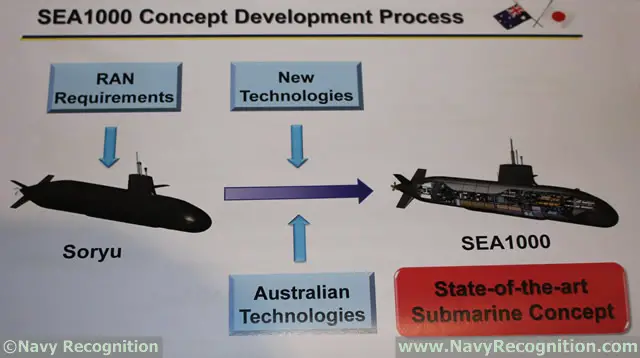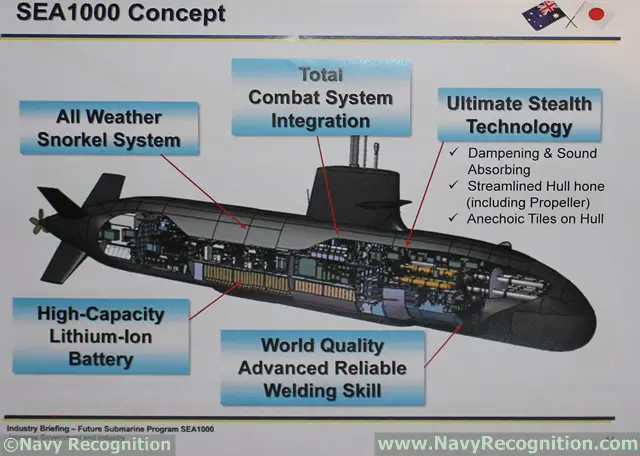COMMENT
Blogger Julien Araneta in Comments [October 12, 2015 at 5:14 PM] below identified an excellent report by Navy Recognition (see below) which concerned PACIFIC 2015, Sydney Exhibition Center, Glebe Island, October 6 to 8, 2015. The original comments from Naval Recognition and additional comments in square brackets are diverse.
The removal of Prime Minister Abbott has forced a rapid revision in Japan's selling style - which concentrates on presentations by civilians from Japanese industry and the Japanese Ministry of Defence. Hence Japan's Defence Ministry spokesman Masaki Ishikawa and Izumi Ishii of MHI now feature. Japan is tightening up its bid and making it more understandable for a wider public including influential Australian politicians. Japan has moved very quickly since Admiral Sato's delegation visited Adelaide in late August 2015.
One issue that did not seem to be mentioned in presentations is pressure hull steel type to be used. This is noting the Soryu's NS110 may still be too confidential for Japan to transfer to the Australian Soryu and in any case may be too difficult to cut and reweld and is weakened when that occurs. The cut/reweld problem may particularly impact on Australian Soryus given their longer desired operational life of 30 years. Japanese Soryus are just operational for 24 years maximum. Thirty years means that the need to replace Australian Lithium-ion Batteries (LIBs) and diesel engines (for higher diesel usage - longer ranges travelled) is much more likely. It is therefore likely that Japan and Australia are formulating another pressure hull steel alloy with fewer issues.
ARTICLE WITH [COMMENTS]
See original Navy Recognition post at http://www.navyrecognition.com/index.php/news/naval-exhibitions/pacific-2015-naval-show-daily-news/3152-japans-government-and-industry-held-an-industry-briefing-on-soryu-submarine-at-pacific-2015.html. The text and photos from that Navy Recognition post are below. In square brackets are comments from Anonymous, S and Pete.
"Japan SEA1000 Industry Briefing at PACIFIC 2015
At PACIFIC 2015, the international maritime exposition currently held in Sydney Australia, the Japanese Government and Industry held an industry briefing on its bid with the Soryu for the SEA1000 program. Japan has a small pavilion at the exposition with scale models of the SEA1000 proposal, a Soryu class, an Atago class Destroyer and the 20DX Frigate. |
 Izumi Ishii, Vice President of Integrated Defence & Space Systems at Mitsubishi Heavy Industries Ltd. during SEA1000 Industry Briefing at PACIFIC 2015 Izumi Ishii, Vice President of Integrated Defence & Space Systems at Mitsubishi Heavy Industries Ltd. during SEA1000 Industry Briefing at PACIFIC 2015 | |||
The briefing which Navy Recognition was attending was presented by Japan's Defence Ministry spokesman Masaki Ishikawa and Izumi Ishii, Vice President of Integrated Defence & Space Systems at Mitsubishi Heavy Industries Ltd. The Team Japan as presented by the Defence Ministry spokesman is to incorporate state of the art technologies from both Australia and Japan into proven technologies for ocean navigation, to work with local industries in whatever arrangement best suited for the Australian Government and to involve Australian industries from the design phase throughout the program. | |||
 Japan SEA1000 Industry Briefing at PACIFIC 2015 Japan SEA1000 Industry Briefing at PACIFIC 2015 | |||
According to Izumi Ishii, the submarine offered for the Australian SEA1000 program will be "a quite different submarine compared to the Japanese Soryu because of its American combat system, larger size and increase range but it will have some commonality with the Soryu". MHI envisions two design centers: One in Japan and one in Australia with a growing Australian portion as the program transitions from concept design to basic design and eventually detailed design. A full scale mock-up of the submarine would be built in Australia for basic training (but no shore integration center is planned for now). While both MHI and KHI (Kawasaki) build Soryus for the JMSDF, only MHI is involved in the competitive evaluation process for SEA1000. The Japanese government has set up a website to help Australian companies getting in touch with Japan industries for the program. MHI will be conducting 1 on 1 meetings with companies accross Australia over the next few weeks. | |||
 ["Anonymous" in Comments [October 12, 2015 at 5:17 PM] indicated SEA 1000 Concept (in the diagram above) shows double layer arrangement of future Lithium-ion Batteries (LIBs) (the Current Soryu adopts single layer arrangement of existing Lead-acid Batteries (LABs), and adopts [very difficult] Gas Tungsten Arc Welding (GTAW), Gas Metal Arc Welding (GMAW) and Shield Metal Arc Welding (SMAW), I think. Training of welders will be crucial element of technology acquisition, especially for NS110-GTAW. Anonymous added that the Japanese Ministry of Defence (MOD) may release a list of subcontractors which is partially disclosed. Translation and understanding of NDS (MOD Standards) are also very important. There are so many things to do.] ["S" in Comments [October 12, 2015 at 5:22 PM] indicated (along the lines) that Japanese research on new main batteries for submarine revealed that the energy density of LIBs was twice that of LABs and lifetime of LIBs was 1.5 times that of LABs. But, from analysis of “Life Cycle Cost (LCC) Management Reports on 23SS (LABs-Soryu) and 27/28SS(LIBs-Soryu)” and other budget papers, S concludes that the life time of current LIBs will be twice that of LABs [that is higher than "1.5 times"] and that prices of LIBs will be high. When adding 24-years of operational life of 22 Japanese submarines with 30-years operational life of the 8 Australian submarines, more than 300,000 LIB unit cells will be needed. There may be a reduction in the price of LIBs caused by mass production effects.] FURTHER COMMENT Reduction of LIB prices may also occur due to much more diverse and frequent non-submarine uses such as: - in UUVs for civilian and military purposes - in large land vehicles (eg. trucks for mining) as well as cars and - much more common Tesla like (solar to battery) static use on an industrial scale.Cost of LIBs will, of course, be one item in the many items that make up the submarine's up-front, training, running and other maintenance costs. Right up until the winner is announced Japanese delegations will likely be travelling around Australia to promote their SEA 1000 solution to politicians, the RAN, businesses and wider public (through the media). Delegations will also be more widely discussing industrial alliances with businesses in all Australian states and territories (as all will likely be involved in the build). Thankyou Navy Recognition for use of your report. Pete |